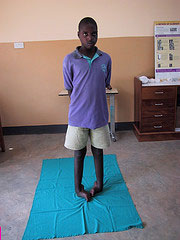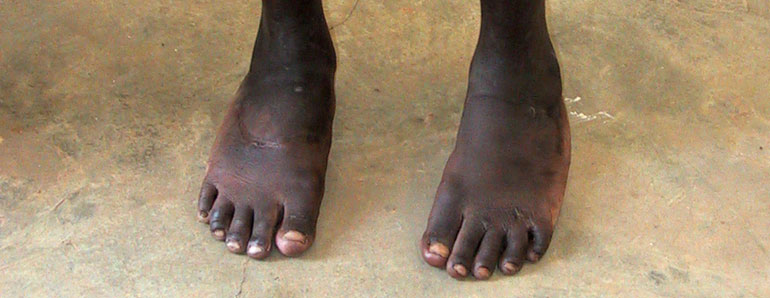 The Uganda Sustainable Clubfoot Care Project builds capacity within Uganda for the detection and management of Congenital Clubfoot.
The Uganda Sustainable Clubfoot Care Project builds capacity within Uganda for the detection and management of Congenital Clubfoot.
What is Clubfoot?
Congenital clubfoot is a worldwide problem. It is estimated that each year 100,000 children are born with the birth deformity which causes the foot to turn inwards by an imbalance in muscles and ligaments. If it is not diagnosed, or is diagnosed but neglected, clubfoot drastically affects an individual’s mobility. In a country were health care delivery is often not easily accessible due to economic and geographic constraints, clubfoot can cause large physical, social, psychological and financial burdens on patients, their families and the community.
How is Clubfoot treated?
Traditionally congenital clubfoot has been corrected through surgery. In 1963, Dr. Iganacio Ponseti from the University of Iowa developed a non-invasive method of correcting the clubfoot deformity. The “Ponseti Method”, as it is dubbed, uses five
successive plaster casts to correct the deformity with a series of gentle manipulations and four subsequent years of bracing. The method, which has a 95% efficacy rate, is perfectly adapted to environments lacking the resources (financial, material and human) necessary to perform corrective surgery.
Clubfoot in Uganda
Dr. Shafique Pirani, a Professor at the Department of Orthopaedics at the University of British Columbia and native of Uganda, began the Uganda Sustainable Clubfoot Care Project (USCCP) in 2002. Initially receiving seed funding from the Rotary Foundation, the Project was awarded Tier 2 funding from the Canadian International Development Agency in 2004. The objective of the project was to make available in a sustainable fashion a universal, effective, efficient and safe treatment of the congenital clubfoot deformity in Uganda. To achieve this objective, the following plan of implementation was put forward:
- Integrate the Ponseti Method within the Uganda Healthcare System using a “train the trainer” approach, such that by the end of the project, a Ugandan child born with a clubfoot would be detected immediately, taken by the parent to the hospital for treatment and that the treatment be available and effective.
- Build capacity for Uganda’s Healthcare Training Institutions to train Uganda’s future healthcare workers in the detection of clubfeet and its management by the Ponseti Method. Again, a “train the trainer” approach was used to ensure long term sustainability.
- Ensure the availability of Plaster of Paris and Steinbeck braces needed for the procedure by working with the Ministry of Health and setting up a consistent supply chain. With the CIDA funded project ending in July 2010, the Uganda Sustainable Clubfoot Care Project has had incredible success in increasing Uganda’s capacity to detect and treat congenital clubfoot. Five schools of higher learning use the USCCP designed syllabus in clubfoot detection and Ponseti clubfoot management. Over 1100 students in health disciplines have benefited from this syllabus. Twenty one (21) regional health centres throughout Uganda (appendix 2) are now equipped to detect and treat congenital clubfoot. Nearly 800 Healthcare professionals have benefited from in-service training in clubfoot detection and management using the Ponseti method.

